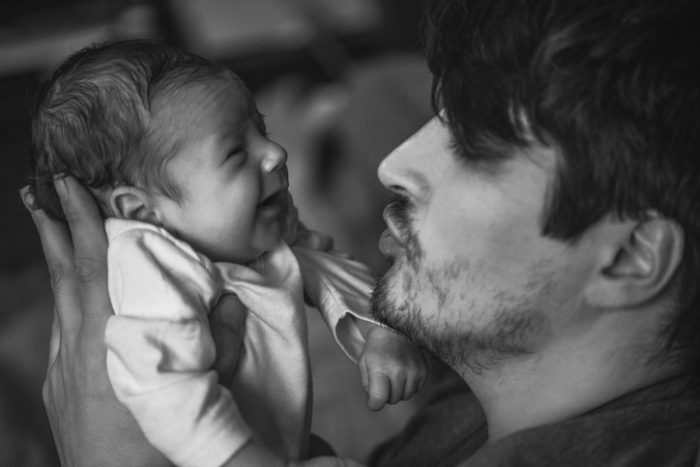
I was recently watching a mother play with her 6-month-old baby on a bench in the park. The mother was lifting the infant up so their faces were aligned, and she was talking to her in a high-pitched melody. The mother set the infant’s feet on her lap, allowing her to bounce, and then continued to talk and make playful faces in an attempt to make the baby smile.
The infant stared intently at her mother’s face watching her mother’s mouth move, listening to the sounds that came out of it and then shifting her gaze to the mother’s eyes and eyebrows that were expressing happiness. Occasionally the infant showed a smirk, which was followed by the mother responding with “such a big smile” in soft, but emotional tone.
This brief interaction between a mother and infant is a great example of just how much infants learn from the faces they see every day. They learn information important for recognizing identity like the color of the skin and shape of the features. They learn to attend to things that move, like eyebrows and mouths, and how these movements go together or occur at the same time they hear sounds, like a voice talking or singing.
Infants learn the sounds of their native language by watching and hearing words and sentences produced from mom’s or dad’s mouth. They learn that faces can signal emotions like happy, sad or angry. They learn that faces have names, like “mom”, “dad”, or “auntie.” Finally, babies learn that when mom or dad is looking at something they might want to turn around and look there too.
What’s so special about faces?
Faces are arguably the most important social stimulus for humans and likely the most effective tool for promoting and supporting infant learning. Newborns come to the world preferring to look at anything that looks like a face, and will look longer at images that have more parts on the top compared to the bottom.
Although the reason for this early preference is debated, an initial looking preference for face-like images, coupled with the fact that faces are all around, moving, expressing emotions, and talking or singing leads infants to spend a significant amount of time attending to faces. This increased attention results in a large portion of early learning occurring simply by watching the faces of others, especially caretakers like mom or dad. In other words, just like books are educational tools used to promote language development and reading, faces are also educational tools during the first year of life.
What do infants learn from faces in the first year of life?
In addition to preferring to look at images that look like faces, newborns prefer to look at their mother’s face within hours or even minutes after birth. However, the preference for looking at mom is only shown when they have seen their mother’s face paired with her voice, presumably because infants can hear the mother speaking while a fetus in the last few weeks of pregnancy.
Once they see the face speaking and hear the voice that they have been listening to for over a month, they immediately encode the mom’s face as familiar and distinguish it from other faces. Babies’ brain responses have also found to be different when they are looking at images of their mother compared to a stranger, suggesting that they can recognize their mother.
Across the first year of life, infants continue to hone and focus their attention to faces. This increased attention allows infants to begin to learn the subtle information that faces have to offer. They learn to follow gaze cues, recognize identities and emotions, and learn language. They also learn the characteristics of people they see and interact with the most, like race and sex.
“Just like books are educational tools used to promote language development and reading, faces are also educational tools during the first year of life.”
When it comes to learning from faces, the people infants attend to the most are those they learn from the most. It is no coincidence that the perception of the basic units of sound and the perception of faces follow a similar developmental path. Language comes from the mouth, which is on the face, and so when infants hear their mother singing to them or the soothing words of their father, they direct their attention to the face.
In fact, during sensitive periods of language learning, infants focus their gaze on the mouths of faces, presumably to better understand the sounds and words that are coming from the mouth. Babies raised in a bilingual home also look to the mouth during language learning, however they begin attending to the mouth earlier and for longer than infants raised in a monolingual home.
What does all this mean for parents, policy makers, and educators?
A large portion of learning in the first year of life occurs in the home and parents are the teachers. The foundations for attention, perception, language abilities and social development are built in the first year of life. Providing a supportive learning environment with lots of interactive face-time is an easy way to teach infants these important skills that may have a long-lasting impact on development.
For example, one recent study reported that when infants pay more attention to faces at 7 months of age, they are more likely to show helping behaviors when they are 2 years old and less likely to show traits associated with poor behavioral outcomes at 4 years of age.
In order to give parents this important face-time with their infants, policymakers in various countries need to re-think the support systems for parental leave and ensure its accessibility for all families.
We found this article by Lisa Scott on bold.expert (Blog on Learning and Development by the Jacobs Foundation).
About the author Lisa Scott.
